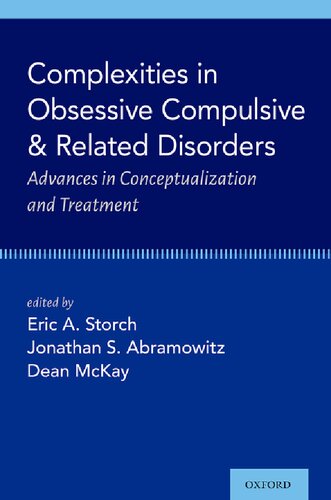پیچیدگی ها در اختلالات وسواس اجباری و مرتبط: پیشرفت در مفاهیم و درمان ۲۰۲۱
Complexities in Obsessive Compulsive and Related Disorders: Advances in Conceptualization and Treatment 2021
دانلود کتاب پیچیدگی ها در اختلالات وسواس اجباری و مرتبط: پیشرفت در مفاهیم و درمان ۲۰۲۱ (Complexities in Obsessive Compulsive and Related Disorders: Advances in Conceptualization and Treatment 2021) با لینک مستقیم و فرمت pdf (پی دی اف)
| نویسنده |
Dean McKay, Eric A. Storch, Jonathan S. Abramowitz |
|---|
| تعداد صفحهها |
480 |
|---|---|
| نوع فایل |
|
| حجم |
5 Mb |
| سال انتشار |
2021 |
89,000 تومان
معرفی کتاب پیچیدگی ها در اختلالات وسواس اجباری و مرتبط: پیشرفت در مفاهیم و درمان ۲۰۲۱
اختلالات وسواس فکری اجباری و مرتبط با آن (OCRDs) در دو دهه گذشته توجه قابل توجهی را به خود جلب کرده است که با گنجاندن یک طبقه بندی جدید از “اختلالات وسواس فکری اجباری و مرتبط” (OCRDs) در DSM-5 به اوج خود رسیده است. این گروه از شرایط شامل OCD به همراه دو وضعیت اخیر (اختلال احتکار و اختلال احتکار) و سایر شرایطی است که قبلاً به عنوان اختلالات جسمی (اختلال بدشکلی بدن) و اختلالات کنترل تکانه (اختلال مو کشیدن) طبقه بندی شده بودند. پیامدهای تحقیقاتی این شرایط، و همچنین روابط آنها با یکدیگر، مهم هستند زیرا مونتاژ آنها بر مکانیسم های مرکزی فرضی با پشتیبانی تجربی محدود تا به امروز متکی است. در واقع، در دهه های گذشته رشد زیادی در تحقیقات در مورد OCRD دیده شده است. این بورسیه در بسیاری از زمینه ها از جمله پدیدارشناسی بالینی، ارزیابی و درمان های روانشناختی رخ داده است. ترکیب کامل داده هایی که در این زمینه ها پدیدار می شوند، فراتر از محدوده یک مقاله دوره ای یا مجموعه ای از مقالات با توانایی بحث جامع درباره تحولات در این زمینه و محرک های موجود در این حوزه ها، بسیاری از کتاب های درسی موجود، هر چند در نوع خود شایسته هستند. خود منسوخ شده است و به آخرین پیشرفت های تحقیقاتی و پیامدهای بالینی در حال ظهور توجهی ندارد. در واقع، دهه گذشته شاهد رشد تصاعدی در دانش در مورد درمان، ارزیابی، و تقویت درمان و علوم پایه بوده است که به طور کامل در مجلدات فعلی گنجانده نشده است (به بحث در مورد متون خاص در زیر مراجعه کنید). بنابراین، ارائه یک کتاب درسی جامع که پیشرفت های اخیر را پوشش می دهد، به روز رسانی بسیار مورد نیاز در زمینه OCR را ارائه می دهد. علاوه بر این، متون اخیر در درجه اول به OCRD ها از دیدگاه بیولوژیکی می پردازند و نظریه های روانی اجتماعی و رویکردهای مداخله ای را نادیده می گیرند که بیشترین پشتیبانی تجربی را از هر رویکرد مفهومی و درمانی برای اکثر شرایط مرتبط دارند. در نتیجه، ادبیات تحت سلطه یک دیدگاه غالب است که به طور کامل داده ها یا دیدگاه های موجود برای پزشکان و محققان خط مقدم را نشان نمی دهد. از آنجایی که محققان و پزشکان به طور فزاینده ای بر روی این موضوع با توجه به تغییرات DSM-5 تمرکز خواهند کرد – همراه با کمبود اطلاعات عینی فعلی در دسترس – این کتاب افزودنی به موقع به ادبیات در راهنمایی پزشکان در پیشرفت OCRD خواهد بود. روی عملکرد آنها تأثیر بگذارد. ثالثاً، تعدادی از شرایط خارج از فصل OCRD DSM-5 اغلب به عنوان «مرتبط» با OCD (مثلاً میسوفونیا) پیشنهاد می شوند.
be beyond the scope of a single journal article or series of articles while having the ability to comprehensively discuss advances in the field and stimulating in these areas
Many of the available textbooks, although meritorious in their own right, are outdated and do not address the most recent research advances and emerging clinical implications. Indeed, the past decade has seen a tremendous growth in knowledge on treatment, assessment, treatment augmentation, and basic science that is not contained fully within existing volumes (see discussion of specific texts further below). Thus, providing a comprehensive textbook that addresses recent advances will provide a much needed update to the field of OCRDs. Furthermore, recent texts primarily address OCRDs from a biological standpoint, neglecting psychosocial theoretical and intervention approaches that enjoy the most empirical support of any conceptual and treatment approaches for most of the relevant conditions. As a result, the literature has been dominated by a single predominant perspective, which does not fully represent the available data or perspectives of front-line clinicians and researchers alike.
As researchers and clinicians will be increasingly focused on this topic in light of the changes to DSM-5 - together with the dearth of current objective available information - this book will be a timely addition to the literature in guiding clinicians in advances in OCRDs that will impact their practice. Third, a number of conditions outside the OCRD chapter in DSM-5 are often proposed as "related" to OCD (e.g., misophonia).



